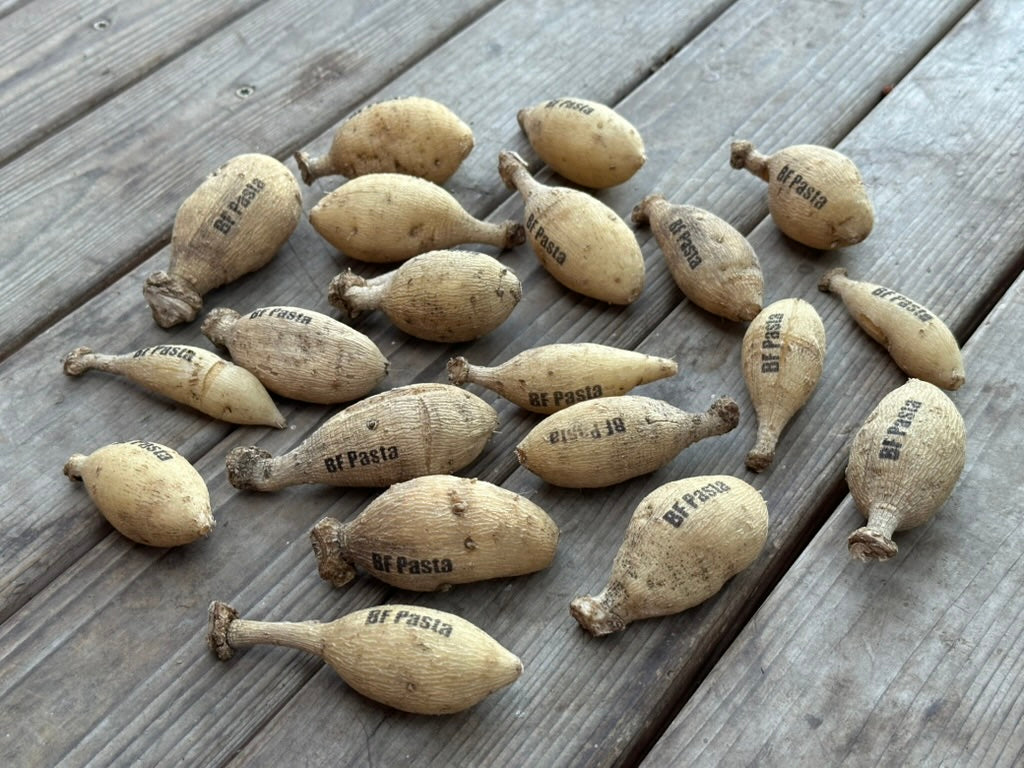
Growing Dahlias from Tuber
Share
The Burfoot Flowers Dahlia Method
Planting & Growing Dahlias
Dahlias bring joy in abundance to the late summer and fall garden. They are vigorous, heavy bloomers and wonderful cut flowers. Growing successful dahlias in your garden will require some trial and error to find the best location and techniques for you and your garden. This guide describes the techniques and methods that have worked best for us over the years, and covers the topics we feel are most important to help you be successful with growing dahlias.
Choosing Dahlias:
- Choose dahlias that suit your growing space and preferences, considering factors such as height, bloom time, and suitability for your climate.
- Purchase tubers from reputable farms and growers for the best tuber and plant health.
- Avoid imported tubers sold at box stores which are more often mislabeled, diseased or poor quality.
Choosing a Planting Location:
- Select a planting site with well-draining soil and full sun exposure (at least 6-8 hours of sunlight per day).
- Ensure the location is sheltered from strong winds, which can damage the tall stems of dahlias.
- Avoid areas prone to becoming ponded or waterlogged, as dahlias are susceptible to root rot in wet conditions.
Preparing the Soil:
- Remove any weeds and debris from the planting area.
- Amend the soil by mixing in 2 inches of compost to improve soil fertility and drainage.
- For best results, consider testing your soil through local resources and following their recommended amendments, such as Conservation Districts or University extension offices.
Planting Dahlias:
- Plant dahlia tubers in the spring after all threat of frost has passed, and the soil has warmed to between 50-60 degrees Fahrenheit.
- A kitchen thermometer can be used to measure soil temperature by inserting it 4-6 inches into the soil in the morning.
- Dig a hole approximately 4-6 inches deep and place the tuber horizontally with the eye or sprout facing upwards.
- Space tubers at least 12-24 inches apart to allow for adequate air circulation and growth.
Watering and Mulching:
- Unless your soil is bone dry and powdery, do not water until you see a green sprout emerge from the soil.
- Once you see green growth, water deeply and regularly, allowing the top 2 inches of soil to dry between waterings.
- It is best to water in the morning or the evening, when the plants are not in sun.
- Watch for signs of under-watering (drooping) or over watering (leaf edges turning yellow then brown).
- Consider installing drip irrigation lines or hoses on a timer to automate the regular watering of your dahlias.
- Consider applying a layer of organic mulch, such as straw around the base of the plants to conserve moisture, suppress weeds, and maintain soil temperature.
Supporting Dahlias:
- As dahlias grow, most require support to prevent their tall stems from falling over or breaking.
- Install stakes or tomato cages around the plants early in the growing season.
- Tie the stems loosely to the supports using soft twine or garden tape, being careful not to damage the plants.
Pinching:
- Pinch your dahlia when it has 3 to 4 sets of leaves by snapping off the central stem right above the newest complete set of leaves. No need to cut or pinch, just bend it to the side and it will snap like a green bean. This promotes a larger, well branched plant and more blooms.
Fertilizing:
- Consider fertilizing dahlias monthly throughout the growing season with a mild balanced fertilizer or one formulated specifically for flowering plants.
- Apply fertilizer according to the manufacturer's instructions, avoiding over-fertilization, which can lead to excessive foliage growth at the expense of blooms.
Sanitization:
- Dahlias are prone to viruses, with 80% of dahlias in the US having at least one virus.
- Virus is difficult to identify and diagnose without a test, which are costly.
- Dahlias with virus will still bloom, but over time fail to thrive and die.
- Prevent the spread of virus to healthy plants by sanitizing your cutting tools between each dahlia plant, no matter if they look sick or not.
- Dip your cutting tools for a minute in a solution of 1 tablespoon of Dawn dish soap in a cup of water, or a 10% bleach solution.
Cutting Flowers:
- Sanitize your cutting tool.
- Find a bloom you want to cut, and feel the petals behind the bloom. If they are soft, wilted or shedding petals, the bloom will not last in the vase. If they are firm, the bloom can be cut.
- Cut deeply into the plant to promote more branching and blooming, by placing the bloom at your wrist, and cutting the stem at your elbow.
Deadheading and Pruning:
- Remove spent blooms regularly to encourage continuous flowering.
- Prune dahlias as needed to remove any damaged foliage, and to improve air circulation and reduce the risk of fungal diseases.
Labeling:
- While your dahlia is blooming, place a label with the variety name or other identifying information.
- Place a stake, or tie flagging tape around the base of the plant.
Watch for Pests & Disease:
- Choose how you would like to manage pests like aphids, such as blasting them off with a hose, spraying with safer soap or similar, or releasing a beneficial insect which will eat the pests.
- Watch for dahlias that are short and slow growing, twisted or distorted leaves, spots on the leaves, or yellowing along the veins of the leaves. If you see any of these symptoms, it is most likely infected with a dahlia virus. Immediately remove and trash the plant.
Digging, Dividing and Storing
In mild climates without deep freezes, dahlias may be overwintered in the ground by covering them with a thick layer of mulch. In most cases however, dahlias must be dug up and stored overwinter for planting the following spring. Finding a method that works for you will require some trial and error. Consider experimenting with different methods, locations and materials to find what works for you faster.
Timing:
- Wait until after the first frost or when the foliage has turned brown and died back before digging up dahlia tubers. This usually occurs in late fall.
Digging:
- Using a garden fork or shovel, carefully dig 12” away from the stem around the perimeter of the dahlia plant, taking care not to damage the tubers.
- Gently and gradually pry and lift the tuber clump from the soil, using your hands to brush off excess dirt.
- Go slowly and be cautious not to break or injure the tubers during this process.
Washing:
- If tuber clumps will be stored whole and divided in the spring, leave dirt in place and proceed to peat moss storage.
- If tuber clumps will be divided in the fall, proceed to dividing.
Dividing:
- Once the tubers have been lifted, inspect them for signs of damage, disease, or rot.
- Discard any tubers that have unusual growths that resemble tree cankers, or cauliflower, which is a sign of bacterial disease called gal.
- Using sanitized pruners, divide the tuber clump into quarters, ensuring that each division has at least one eye or growing point.
- Sanitize your cutting tool between each tuber clump to prevent spreading disease.
- Stop there, or continue to divide each quarter into individual tubers, again ensuring that each division has at least one eye or growing point, and an intact neck.
- Trim away any thin roots, tubers smaller than a AA battery, dead or withered parts of the tubers.
Drying:
- Allow the divided tubers to air dry for up to 24 hours in a cool, dry location to allow any cuts or wounds to dry and callus over.
- Watch for wrinkling, or softening of the tubers, caused by excessive drying. If tubers become dehydrated, re-wet them with cool water and dry for a shorter period before proceeding to storage.
Choose a Storage Method:
Vermiculite:
- Ensure you tubers are properly dried, and are cleaned of any loose roots, small or damaged tubers.
- Fill a zip lock bag or plastic bin with coarse or medium vermiculite to create a layer at the bottom.
- Place the dahlia tubers in the container, spacing them apart and ensuring they do not touch each other.
- Cover the tubers completely with vermiculite, ensuring they are surrounded on all sides.
- Seal the zip lock bag or plastic bin.
Peat Moss:
- Fill a plastic bin with peat moss to create a layer at the bottom.
- Place the dahlia tubers or tuber clump in the container, spacing them apart and ensuring they do not touch each other.
- Cover the tubers completely with peat moss, ensuring they are surrounded on all sides.
- Do not completely seal the plastic bin. Create a ventilation hole in the bin, or leave the lid cracked open.
Saran Wrap:
- Wrap each tuber in several layers of saran wrap, ensuring a tight seal. If wrapping multiple tubers together into a single bundle, do not allow the tubers to touch.
Storage:
- Store the tubers in a cool, dark location with a consistent temperature between 40-50°F (4-10°C), such as a crawlspace, basement or garage.
- It is vital that your tubers are not exposed to freezing temperatures, which will immediately kill them.
- Check the tubers 2 weeks after placing into storage, and then periodically throughout the winter to ensure they remain firm and healthy.
- If any tubers show signs of rot remove and trash them immediately and crack your container open to decrease humidity for remaining tubers.
- If any tubers show signs of dehydration, lightly spritz your storage medium, and reduce the ventilation of your storage container.
Replanting:
- In the spring, when the danger of frost has passed and the soil has warmed up to 50-60 degrees, prepare the dahlia tubers for planting.
- If tubers are dormant, without any sprouts, bring them inside 2 weeks before planting to wake them up.
- Inspect your tubers and choose tubers which are firm, undamaged, without any rot and show a swollen eye or growing sprout to plant.
- If any tubers have developed unusual growths, throw them away immediately and consider throwing away their storage medium, and any tubers stored in the same container.
- Watch for rounded, canker like growths where the tuber connects to the clump, which is a sign of crown gal.
- Watch for white, green or pink sprout growth which resembles cauliflower, which is a sign of leafy gal.
